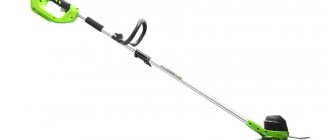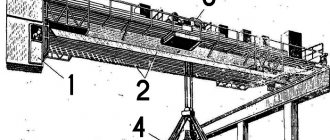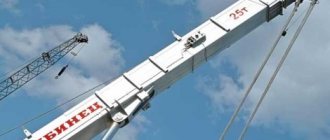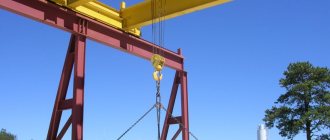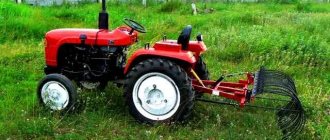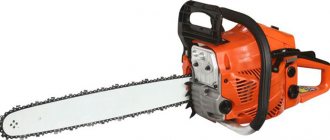The classic pipe layer is a self-propelled device based on a crawler tractor. It is designed for moving, positioning, and laying pipe products of various diameters in the design position, as well as for performing related loading and unloading operations. Pipelayers are widely used in oil and gas, utilities and other areas, at construction sites, and transshipment depots. They can easily move with cargo on unprepared sites, as well as on pipeline construction sites.
Design and principle of operation
A pipe layer is a type of modular equipment. Its basis is a basic tractor device, which is a combination of an engine, a chassis and a power transmission to the tracks. The working elements are attachments and the crane boom. This module includes power take-off and winch drive mechanisms, pulleys with a load hook, an upper frame and a counterweight with a cylinder.
The pipelayer control system includes elements that provide control over the chassis of the unit and its attachments. To ensure stability during work operations, counterweight devices are used, which are moved by hydraulic cylinders.
As additional equipment, complete with pipelayers, dumps are also used for digging trenches and related operations. And some models of units are used during welding and drilling work, when driving piles, and also as tractors.
Controls
Motion Control
The tracked platform is directionally controlled and rotates in place by braking or reversing one of the tracks.
Wet multi-plate steering clutches are equipped with a lever control with a hydraulic drive. The steering gear brakes are belt-type and have a foot pedal drive with a hydraulic booster unit.
Actuator control
It is carried out by three levers:
- setting the gear lever to the neutral position, selecting high or low speed;
- lever for changing the position of the boom;
- hook device lever.
Important! To facilitate control of the actuators, the actions of the clutch drives and band brakes of the winch are coordinated.
Exhibition of counterweights
A hydraulic cylinder is used.
All systems, panels, levers and switches are designed and placed with ergonomics in mind. Provide comfortable and efficient work for the operator.
Types of pipe layers
There are several significant parameters of pipe layers, on the basis of which their classification is built. One of them is the diameter of the pipes with which the unit is used. Depending on this, three classes of devices are distinguished.
- For working with small diameter pipes. The maximum permissible value of this parameter is 530 mm.
- For working with medium diameter pipes. This parameter varies from 540 to 1200 mm.
- For working with large diameter pipes. The value of this value is above 1300 mm, but not more than 1430 mm.
Trumpeters blow into pipesReview of the pipelayer market
The small but distinctive pipe-laying market is going through hard times, just like the entire economy. According to preliminary estimates by CHETRA-PM experts, in 2015 the capacity of the pipelayer market decreased by 20% compared to 2014. It is obvious that the downward trend that started in 2012 will continue in 2016–2017. At the same time, pent-up demand accumulates, which is met by repairing pipe layers; fortunately, a solid repair base has accumulated for domestic and old imported models.
The peculiarity of the pipe laying market is not only its small capacity, when one large contract can radically change the structure of the market. The operating intensity of the pipe layer is lower than that of its related bulldozer, which increases its service life and renewal cycle. A pipe layer is a lifting mechanism that is subject to the same requirements as a crane, that is, the presence of load limiting equipment, registration of a “pipe laying crane” with Gostekhnadzor, and periodic inspections. Pipe layers are subject to the same HS code as crawler cranes. A pipelayer also differs from a crane, since it can have emergency cargo release.
Pipe layers are divided depending on the diameter of the pipes being laid: small - up to 529 mm, medium - up to 1200 mm and large - up to 1420 mm. The domestic industry can provide small and medium-sized pipe layers; for large ones, capable of working with a “one and a half meter” main pipe, it is somewhat more difficult; there is a large share of imported machines from Komatsu, Caterpillar and Liebherr. The domestic production program includes large pipelayers.
Deliveries of equipment from such manufacturers as LiuGong (Dressta brand), Shantui and Taishan (DaiFeng brand) have been sporadic over the past few years. Thus, Shantui pipelayers for 2012–2015. delivered less than 10 units. We can say that there have been no imports of Chinese pipelayers and there are no prerequisites for them to appear in 2016, mainly due to the 1/12 ratio of the yuan to the ruble, which serves as the best protective duty. Pipelayers are not subject to the anti-dumping duties imposed on Chinese bulldozers in December 2015, but, as we see, such measures are not necessary.
For reference: the Chinese market is dominated by pipe layers from two major manufacturers - Shantui and Taishan (DaiFeng brand) with approximately equal technical characteristics, while DaiFeng is slightly higher in quality and price. Of course, besides them, there are many more factories in China that produce pipe layers, such as PengPu, Pipeline, but their supplies to the Russian market have been sporadic throughout modern history.
Volvo pipelayers based on crawler excavators represent a separate, new direction. They began to take a closer look at these machines both abroad and here, they began to be purchased for testing, mainly in auxiliary work. We can say that things have progressed, and today Volvo CE is producing pipelayers of the second generation with improved characteristics.
The leader of the domestic market , CHETRA-Industrial Machines, produces a full range of pipe layers, consisting of five basic models:
- TG122 with a lifting capacity (hereinafter referred to as lifting capacity) of 12 tons at an outreach of 2.5 m and 26.5 tons at an outreach of 1.22 m;
- TG222 g/c 21 t at an outreach of 2.5 m and 44.2 t at an outreach of 1.22 m;
- TG302 g/p 31 t at an outreach of 2.5 m and 65.7 t at an outreach of 1.22 m;
- TG503 lift capacity 50 t at an outreach of 2.5 m and 104.5 t at an outreach of 1.22 m;
- TG511 g/p 51 t at an outreach of 2.5 m and 104.5 t at an outreach of 1.22 m.
The first three models can be classified as middle class, the last two – heavy. Pipelayers are built in accordance with a modular concept, which CHETRA-PM has extended to the entire model range. Large components of the power plant, chassis, power transmission, cooling system, working equipment, and cabin are arranged in the form of modules, which, if necessary, are removed and replaced entirely. The removed module is repaired in specially prepared rooms, bench tests are carried out and it is prepared for quick and correct installation on the machine. For large-scale projects, this is the only correct solution to quickly, in a matter of hours, eliminate faults and return the machines to operation.
All models feature a box-section boom with mechanical lifting and lowering, double-drum winches with hydraulic drive and control and permanently closed disc brakes, and stackable counterweights with hydraulic drive. For each model there are two arrow length options. The hydraulic distributor allows you to combine the movements of the boom and hook at different speeds and in any direction. The advantages of CHETRA pipelayers also include a wide track, combined with a large length of the supporting surface and adjustable counterweights, which ensures machine stability on slopes.
At the request of the customer, the base machine can be equipped with both a domestic YaMZ engine and an imported Cummins engine with a power of 110 kW for the “junior” model to 350 kW for the “senior” model.
Since pipelayers operate in various climatic zones from the Far North to the deserts of Central Asia, the designers tried to provide the operator with comfortable conditions - a comfortable, sealed cabin, air conditioning, and autonomous heater.
The Tractor Plants concern, which includes CHETRA-PM, aims to expand its share in the Russian market and increase exports, for which it continues to invest in production and R&D, develops a dealer and service network and participates in major Russian and international exhibitions. They are optimistic here and plan to increase production and sales volumes in the medium term.
traditionally dominates in the segments of small and medium-sized pipe layers with a lifting capacity of up to 45 tons and an outreach of 1.22 m. The main advantages of Chelyabinsk pipe layers are price and maintainability, and 2015 only emphasized and highlighted these advantages. The basis for these competitive advantages is the most popular and maintainable industrial tractor T10M.
The plant produces two basic models TR12 with a lift capacity of 27 tons at an outreach of 1.22 m and 12.5 tons with an outreach of 2.5 m, TR20 with a lift capacity of 41 and 20 tons in several configurations. TP12 pipelayers work with pipes with a diameter of up to 720 mm, TP20 – with pipes with a diameter of 1020 mm, that is, both models belong to the middle class.
The base machine for both models is a special modification of the serial tractor T10MB.0121-5, which is distinguished by a gearbox with an increased gear ratio in first gear for slow and smooth travel under load. Plus an increased track and length of the track support surface (seven track rollers instead of six) with wide shoes (690 mm instead of 500 mm), which ensure machine stability when working on slopes with extreme loads and minimal pressure on the ground.
The configurations of pipelayers differ, firstly, in the winch drive: mechanical or hydraulic.
Both solutions have their advantages. Hydraulic provides smooth, stepless speed changes and convenient, easy control. The mechanical drive from the upper shaft of the gearbox through a three-stage gearbox, chain transmission and cardan shaft is more cumbersome and archaic, but unlike hydraulics it is insensitive to temperature, be it the Siberian frost or the heat of the Kara-Kum. In addition, the mechanical drive also does not stand still, but is being improved. Thus, to increase accuracy and reduce dynamic loads, the minimum speed of lifting and lowering the load has been reduced and the speed of lifting and lowering on a free hook has been increased.
Lifting equipment includes an A-shaped box-section boom. The standard boom is 7 m long; at the customer’s request, a 9 m long boom can be installed. There is also an option with an 11-meter boom and a jib (extension), which increase the under-boom space and allow the work of large but light loads. The pipelayer can also be equipped with a dozer blade with a drawing prism of 3.6 m3.
Supplies of pipe layers from the Berezovsky Repair and Mechanical Plant (BRMZ LLC, Sverdlovsk region, Berezovsky) have decreased significantly, however, orders for the TBG-16 and TBG-20 models are being received. Pipe layers are in demand for the construction, reconstruction and repair of pipelines with a diameter of up to a meter. The plant will also enthusiastically assemble a large TBG-90 pipe layer based on an imported industrial tractor if it receives such an order.
The base machine for the TBG-16 12.5 t at a reach of 2.5 m and 16 t at a reach of 1.22 m is the same ChTZ T10M tractor - the most common and repairable. The pipe layer is designed to work with pipes with a diameter of up to 720 mm. For work in wetlands, a version based on the T-10MB swamp tractor is available.
The TBG-20 pipelayer with a capacity of 20 tons and an outreach of 1.22 and 2.5 m and a weight of 28 tons is designed for laying pipes with a diameter of up to 1040 mm in wetlands and is built on a swamp modification of the ChTZ T-10MB tractor with shoes 900 mm wide.
The crane equipment of both models differs significantly from the Chelyabinsk one and consists of a tubular boom 7 m long (9 m on request), made of high-strength steel, a mechanism for raising and lowering the boom using a hydraulic cylinder on TBG-12 and using a winch on TBG-20, cargo Zollern winches with hydraulic drive and control on TBG-12 or two single-drum winches on TBG-20, counterweight with hydraulic control. Pipelayers are equipped with modern safety equipment AZK-110.
The widespread use of high-quality and reliable imported components, on the one hand, significantly improves the technical and operational characteristics of the machine, and on the other, increases its cost. The plant is looking for ways to reduce prices while maintaining the level of quality and reliability.
Caterpillar Corporation was directly involved in the emergence of pipe layers as a type of construction equipment. The need to lay hundreds of kilometers of pipelines at the beginning of the twentieth century, primarily in the United States, required mechanization. The only mobile and sufficiently powerful basic machine at that time was a caterpillar tractor. That is why the pipe layer is still built on the basis of an industrial tractor. The crane equipment of that time was a bulky structure with a strapping frame around the entire tractor, since the design of the tractor did not provide sufficient strength. But already in the 1930s. The pipelayer has acquired a modern look with a crane boom resting on the left track frame and a counterweight on the starboard side.
The Second World War gave a powerful impetus to the production of pipe layers. Germany and Japan imposed suffocating sanctions against the United States and allies and, flouting international law, sank American tankers. The Americans had to remember that they had their own oil reserves on their territory and urgently built pipelines, which required many pipelayers.
In the USSR, intensive production and development of pipe layers began in the 1950s. and is also associated with the development of oil fields.
The Caterpillar Corporation produced tractor-based pipelayers using crane equipment from the Trackson Company of Milwaukee until 1951, when it acquired the manufacturer. The takeover opened up the opportunity to create a pipe layer as a separate type of equipment with integrated crane equipment and, accordingly, with better characteristics. Previously, this possibility was not available for patent reasons. The first Caterpillar 583 pipelayer with integrated crane equipment was introduced in 1955. Today's lineup continues the tradition established by the 583.
Today, Caterpillar produces a model range of pipelayers, updated in 2008: PL61, PL83 and PL87 with a capacity of 18, 72 and 97 tons with an outreach of 1.22 m. The “junior” model PL61 is unified in many components and assemblies with the D6K bulldozer. These include the C6.6 ACERT diesel engine, an electronically controlled hydrostatic transmission, a SystemOne chassis with an oval track, and a cabin with improved controls - joysticks. The boom and hook drive is divided into two interchangeable hydraulic winches with oil-immersed disc brakes to simplify unit repairs in the field.
The PL83 and PL87 models are based on current crawler tractor models with raised drive wheels. The track has been lengthened and the rear wheel has been moved further back to increase the footprint. Heavy-duty, hydraulically controlled counterweight provides greater lifting capacity. The low-mounted winch block has reduced transport dimensions. Hydraulic boom and hook winches with oil-immersed disc brakes are interchangeable and pin-mounted for easy replacement. Boom equipment includes a box-section A-boom, with an extended boom available on request. The hook hanger has been reduced in size to improve visibility of the load. Boom and hook control functions have been moved to a new joystick for the right hand.
Liebherr the construction of gas and oil pipelines such as TRANSNEFT. Liebherr offers Russian customers three models of pipelayers: RL 44 Litronic, RL 54 Litronic and RL 64 Litronic, capacity 45.9; 70 and 90.8 t at a reach of 1.22 m, launched on the market in 2011–2012. Among oil and gas workers, the most in demand is the heavy pipe layer RL 64. Models RL 44 and RL 54 are less popular, however, they can be found in the most remote areas of the country when constructing infrastructure. Liebherr pipelayers are supplied to Russia in a special low-temperature design, which allows them to operate in temperatures down to –50 °C.
The main features of all three models, built on common principles, are the proprietary Liebherr hydrostatic transmission, asymmetrical chassis, and boom lifting with a hydraulic cylinder. The hydrostatic transmission provides continuously variable speed control and high maneuverability. The undercarriage and boom are controlled using two proportional joysticks. Since the drive is used as a wear-free service brake, no additional braking is required even when driving on steep slopes.
Pipelaying equipment includes an A-shaped box-section boom with a length of 6.01 m (RL 44), 7.3 m (RL 54) and 8.5 m (RL 64), a hydraulically driven single-drum, reversible hook winch with a multi-disc brake, and a hydraulically controlled counterweight. . An extended boom is available on request.
In the modern economy, the service and restoration program for Liebherr-Reman components, which has been operating at the Liebherr plant in the Nizhny Novgorod region since the end of 2014, has become of great importance. In a specialized workshop, diesel engines are restored and guaranteed as if they were new.
The Swedes, as lovers of alternatives, today produce second-generation pipe layers based on crawler excavators. Volvo models with tipping loads of 51 and 89 tons (at a reach of 1.22 m) as standard, that is, the maximum weight of loads with which these machines work reaches 51 and 89 tons, and when the PL4809D model is equipped with an additional counterweight weighing 4 tons, its tipping load reaches 102 tons.
As mentioned above, when in the era of coal and steam there was a need for a mechanism for high-speed laying of pipelines, the only option for a self-propelled base machine was a crawler tractor, although the advantages of a crawler excavator with a turntable are obvious. Firstly, an excavator-based pipelayer can perform loading and unloading and moving pipes much faster while standing still (without destroying the site surface, as happens when turning tracked vehicles, which is especially important on technological sites where it is constantly necessary to turn around one place, for example, when feeding pipes into a pipe bending machine), while maintaining the ability to move with a load on the hook. Second, by turning the boom toward the grade and thus shifting the center of gravity, the pipelayer can safely operate on a greater grade than a crawler tractor.
Already in our time, attempts were made to build pipelayers on the basis of a single-bucket crawler excavator, but even with them the crane boom rested on the chassis frame, and all the advantage of the turntable was lost. The main reason why a crane boom was not installed instead of an excavator boom lies in the insufficient strength and reliability of the slewing bearing. It was only recently, in 2008, that Volvo CE was able to strengthen the lifting gear so that it could withstand the extreme loads typical of pipelayers. Volvo engineers consolidated and developed the concept, and lawyers protected it with patents from the encroachments of those who like to copy. Once the patents expire, there will be plenty of people willing to compete with Volvo CE.
So, the operation of the first generation Volvo pipelayers in real conditions gave the developers a lot of information, on the basis of which in 2015 two models PL3005D and PL4809D were released - medium and large instead of two large, as was the case with the previous generation. As a result, the model range has been improved; it now covers a wider range of pipeline construction and repair work.
The large PL4809D pipelayer has 70% more traction than its predecessor, allowing it to move and maneuver on slopes of up to 30° with a heavy hook load, and move faster on level ground.
The PL4809D is mounted on a crawler carriage with hydraulic extension, while the PL3005D has a carriage without extension, but this machine is compact enough to be transported on a low-loader heavy-duty semi-trailer without removing any components, which significantly reduces production costs and increases the mobility of the mechanized column.
The large pipelayer is equipped with a 9.2m boom plus an optional 2m extension and a 10t counterweight plus a 4t additional counterweight for increased lifting capacity. The PL3005D comes with a standard 7.3m boom, a 1.8m jib and a standard 6.8t counterweight. To reduce ground pressure and improve flotation, 1050mm wide shoes can be fitted on the PL4809D and 800mm wide on the PL3005D. A durable mechanical lock ensures that the turntable is locked at any angle of rotation relative to the chassis when lifting loads on slopes and when making taps.
Pipe layers, as well as Volvo excavators, are optionally equipped with so-called hydraulic lines X1 and X3 for connecting additional hydraulic equipment, for example, installations for cutting pipe ends for welding. The standard hydraulic system can provide hydraulic drive for various additional devices, such as a welding generator. When converting the machine into an excavator, these lines can be used to operate a hydraulic hammer or other units.
An additional difference and advantage over pipelayers based on a crawler tractor is the lifting cabin. The original hydraulic four-link cab lift mechanism provides the operator with excellent visibility of the trench and work site.
The intensity of operation of a classic pipe layer is low due to its narrow specialization, which increases the cost of ownership. Volvo pipelayers do not have this drawback, since they combine three machines: a pipelayer, a crawler crane and a single-bucket construction excavator. Two technicians can turn a pipelayer into an excavator in a maximum of 4 hours thanks to factory-installed hydraulic lines and connectors. This allows you to increase machine utilization up to 100% by diversifying it as needed, thus reducing the cost of ownership.
Volvo pipelayers are supplied to the Russian market with an “Arctic package”, which ensures operation at temperatures down to –45 °C and below. In 2015, Volvo delivered three PL4611 pipelayers, as well as two PL4809D and one PL4608 pipelayers. A Volvo CE representative noted that these vehicles are included in mobile emergency recovery trains.
Thus, there are manufacturing plants of high-quality pipe layers of all sizes and models, there is a demand for this equipment, there are many projects where this equipment should be used. There is only one thing missing - financing, but this topic lies not in the economic, but in the political plane.
Pipelayer parameters
A pipe layer is special equipment designed to work in difficult conditions. By default it is powerful, productive and durable. The main parameter of the machine is its load capacity, expressed in tons-force (tf). It determines the ability of the unit to perform lifting work with loads weighing from 0 to the maximum value. By default, the machine is capable of accepting vertical loads applied to the hook. The load stability moment determines the ability of the pipelayer to withstand external overturning loads. This parameter is also measured in tf.
The main working part of the pipelayer is the boom. Its reach may differ in different models, but in practice it rarely exceeds 8 m. The most durable and reliable steel-based materials are used to make the arrow. Other significant parameters of pipe layers:
- specific material consumption and structural mass;
- maximum lifting height;
- diesel power, traction force on the drive wheel;
- speed of movement, lifting and lowering of the hook;
- specific pressure on the ground and others.
The optimal pipelayer is considered to be the one that has the greatest traction force with the least load on the surface.
History of the creation and production of pipe-laying cranes.
Pipelayers are usually manufactured on the basis of tracked tractors (less often wheeled), which are mass-produced. The tractor chassis is modified and a boom on a flexible suspension, winches, and a hydraulic counterweight are mounted on it on the left side to ensure the required stability. The cabin is also being modified to increase visibility on the left side and improve operator comfort. The transmission is usually hydromechanical. A bulldozer blade is not installed on heavy models. To reduce pressure on the soil, the tracks on the left track are wider than on the right.
The largest pipelayer has a maximum lifting capacity of 100 tons at an outreach of 1.2 meters, and its weight is more than 60 tons. The lifting height of the hook reaches eight meters and the reach is nine meters. This is enough to lay any pipes with a diameter of up to 1420 mm, which are produced today by the Russian metallurgical industry.
For laying small-diameter pipes, our factories then produced several models of special lifting equipment. But when the need arose to lay main gas pipelines with a diameter of 1420 mm. more load-lifting stacking cranes were required. The domestic industry did not produce such machines, and foreign manufacturers (Komatsu, Caterpillar) refused to sell them. It was decided to master the production of pipe layers with a lifting capacity of 50 tons at the Stroymash plant, Sterlitomak. Equipment with the required characteristics was designed and put into production.
In recent years, Russia has been building a gas pipeline to China. Construction is being carried out in difficult permafrost conditions, with a complete lack of access roads. A significant part of the gas pipeline has already been built, but a huge amount of work remains to be done, which will require special equipment for laying pipes. In the west, the southern and northern streams are being built. A significant part of the pipelines will be laid along the seabed, which will require special marine pipe-laying vessels, the production of which has yet to be mastered by Russian shipbuilding enterprises.
Cat® Pipe Layers
Equipment for laying pipes and related work is produced by both Russian and foreign manufacturers. One of the most popular in the world in this segment is Caterpillar. For many years it has been a leader in the production of high-tech equipment for road construction. Its pipelayers, offered under the Cat® brand, have well-balanced lifting capacities, high maneuverability, and are capable of operating in the most difficult conditions. The engines of the machines meet international standards, and the operator’s cabin is ergonomic and provides good visibility. We suggest you familiarize yourself with all Cat® pipelayers presented in the catalog, and also choose the optimal model to order. You can not only purchase equipment from us on favorable terms, but also receive professional service and buy the necessary spare parts.
Additional equipment that increases the functionality of the machine
Manufacturers offer optional installation on the machine:
- Mechanical torque control devices on the boom . Signals the operator about the maximum load load during lifting and the inadmissibility of continuing work without adjusting the settings of the counterweight and boom device.
- Warning unit against over-stretching of the hook pulley . Eliminates over-tightening, tangling and breaking of the cable on the hook with damage to the lifting boom equipment.
- Load indicator device . Notifies the operator that the lifting capacity and boom lift angle are within optimal parameters.
- Additional towing winch for auxiliary operations.
Cabin and workstation of the pipelayer operator
The pipelayer's steel cab provides the operator with ample space and comfort. A powerful and high-performance heater is capable of keeping the interior of the cabin warm even in extremely cold weather and severe frosts. The cabin sealing is very good, providing decent not only heat protection, but also dust and noise and vibration protection.
The cab of the Komatsu D355 pipelayer is largely glazed, and thanks to this, the operator of the special vehicle has the opportunity to have a complete overview of everything that is happening on the site where his special equipment is working. Also, the operator always has maximum visual control of the individual components of the pipelayer.
The manufacturer equips the cabs of pipelayers with emergency protection systems. For this purpose, steel inserts are used, reinforcing the entire cabin structure, and it is also possible to install protective grilles.
The controls for the movement and working equipment of the pipelayer are designed in full accordance with current ergonomic requirements - they are all quite convenient and located literally at hand. Integrated brakes and steering clutches provide responsive and trouble-free steering. The counterweight position control is located next to the operator's seat. This chair, equipped with a hydraulic suspension, helps you work long shifts productively and without fatigue.
The cabin suspension is based on viscous-type dampers, which significantly softens shaking and vibration loads on the workplace, creates a comfortable environment for the operator and increases the overall service life of components and parts.
The main control of the crane's actions: the movement of its boom and hook is carried out by three levers, which are connected to a hydraulic servo drive. Komatsu pipelayers are required to be equipped with a special monitoring system. The sensors that are part of it are located on devices that have electronic controls. The information received from this system is immediately quickly processed by the central unit and sent to the operator control panel of the Komatsu D355 pipelayer. Protection is built into the equipment, which makes it possible to avoid management errors. The lever used to switch the operating modes of the lifting mechanism has a special locking unit.
There is a torque indicator. It is a safety device that alerts the operator when the lift limit has been reached and also notifies him to adjust the boom position. A special alarm device for excessive lifting is designed to warn the operator about excessive lifting of the hook roller block, preventing damage to critical equipment components in cases of cable breakage. The Load Indicator maintains a high level of pipelay safety by helping the operator determine at a glance the acceptable operating range and rated load capacity based on boom angle.
Torque Flow Transmission
Komatsu's proprietary Tork Flow progressive transmission reliably provides easy and smooth gear changes, as well as instantaneous forward and reverse shifting.
As part of the original Komatsu TORQFLOW transmission -
- three-element, single-stage, single-phase liquid-cooled torque converter;
- gearbox with planetary gear and multi-plate clutch with hydraulic drive and forced lubrication.
The transmission is designed to ensure optimal heat dissipation. Gear shifting (three forward gears and three reverse gears), as well as forward-reverse switching, is done using a single lever. At any time on the work site, it is possible to set the optimal speed of the special vehicle in relation to the specific work being performed. Accidental starting - the start of the special vehicle from a standstill is prevented by the gear shift lever lock and the neutral locking safety switch.
The speed of movement of the pipelayer is: forward: 1st gear – 3.5 km/h; 2nd gear – 6.2 km/h; 3rd gear – 10.5 km/h; reverse: 1st gear – 4.2 km/h; 2nd gear – 7.7 km/h; 3rd gear – 11.2 km/h.
The final transmission is with a 2-stage gearbox consisting of a spur gear and a planetary gear. It extremely weakens the impact load on the power transmission units. The segmented sprocket rims are secured with bolts, making them easier to replace in the field.
In order to reduce the deforming load on the transmission units, the manufacturer of the pipe layer provides rotation transmission through spur and planetary gear mechanisms. To quickly change the segmented drive sprocket, a bolt-type fastening is used.
Working equipment for pipe laying
The Komatsu D355 pipelayer has a serious lifting capacity and is ideal for working on large pipelaying sites and areas, wherever pipe laying with a diameter of more than 48 inches is required. The working radius of the pipes with which this special machine works is from 1.3 m to 8.5 m.
The hook speeds (with an empty drum) on lifting and lowering are the same - 6.8 m/min (low), 13.3 m/min (high). The boom has a box-section design. It is made of steel, which has high tensile strength, and is designed for heavy duty use. The wire-controlled boom is equipped with an automatic stop device at the maximum lift position, which prevents excessive lifting of the boom. The boom length is 8.56 meters. Its mass is 2.52 tons.
The special vehicle is equipped with a winch, the control of which is hydraulically driven; two drums; a reversing mechanism that allows you to simultaneously move both the hook and the boom. The hydraulic drive is equipped with a planetary gearbox. The dimensions of the parts of this winch are as follows: hook drum - 290 mm diameter x 334 mm width; boom drum 290 mm diameter x 166 mm. The cable capacity is equal to: hook (with attachment) – 20 mm x 95 m; boom (with attachment) – 20 mm x 65 m; hook (max) – 20 mm x 190 m; boom (max) – 20 mm x 80 m.
The counterweights are segmented plates weighing 1530 kilograms. There are six plates in total. The control is equipped with a hydraulic drive. The total weight of the equipment (including six plates, frame and hydraulic cylinders) is 12,900 kilograms.
A grooved-type drum for the hook cable with an optimized roller prevents uneven winding of the cable and reduces its lateral slippage at the edge of the drum. And the adjusted location of the drum roller helps to correct deviations in the direction of the cable at the beginning of winding. Rocking of the pipes and the possibility of their accidental damage due to sudden stops during the lifting or lowering process are prevented by hydraulic transmission on the hook movement drive.
Engine Komatsu D355
The pipelayer is equipped with a Komatsu SA6D 140-2 four-stroke in-line six-cylinder diesel engine, liquid-cooled, turbocharged. The engine displacement is 15.24 liters. The cylinder diameter is 140 mm, the piston stroke is 165 mm. The power of this power unit is: gross (SAE J1995) - 277 kW (377 horsepower), at a rated speed of 2,000 rpm; net - (ISO 9249 / SAE J1349) - 265 kW (361 horsepower), also at 2,000 rpm.
The Komatsu SA6D 140-2 diesel engine is equipped with direct diesel fuel injection, a mechanical fan, an air cleaner, an alternator, a water pump, a lubrication pump, a muffler and a fuel pump, and a mechanical all-mode speed controller. Lubrication is carried out by forced means, using a gear pump; The system has a full-flow filter. The dry air cleaner with automatic dust extraction ensures longer filter element life and has a dust indicator to simplify regular maintenance.
Pipelayers of this model are equipped with autonomous internal combustion pre-heaters, which heat up the diesel engine, power transmission and battery box. The electric heater, with an external power source, is capable of always maintaining the power unit in a warm state.
